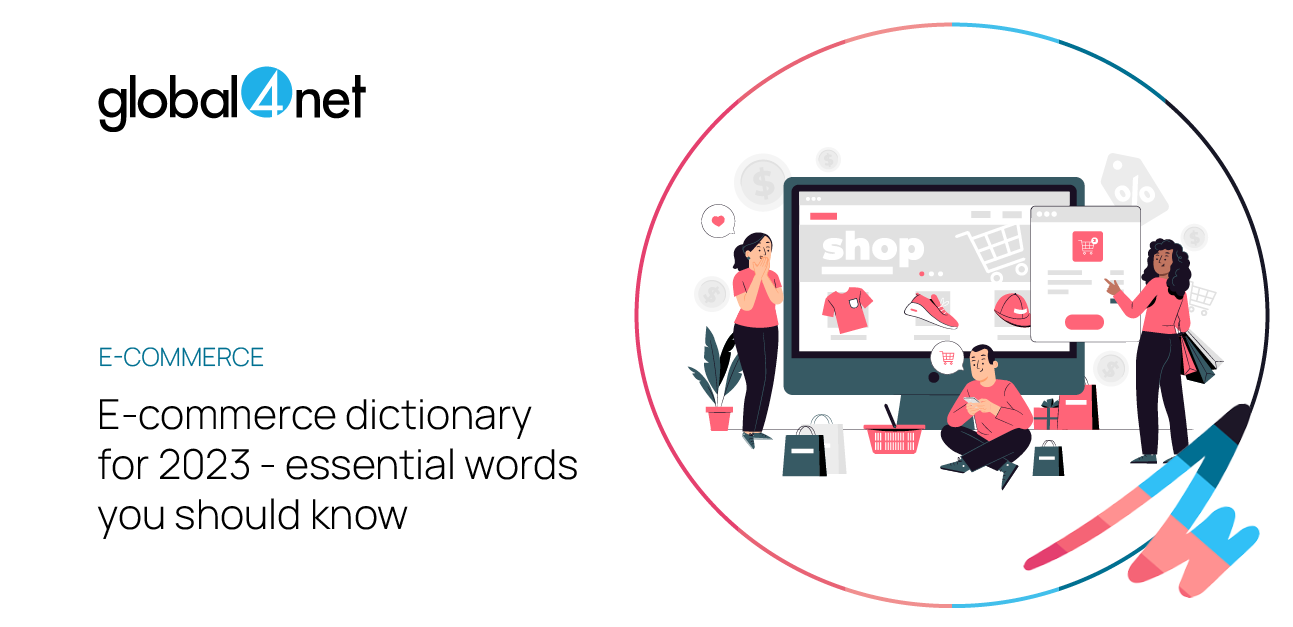ul. Strzegomska 2-4
53-611 Wrocław
NIP 8992786490
KRS 0000608120
REGON 363987723
Global4Net Sp. z o. o.
+48 71 358 41 00
© 2009 – Global4Net. All Rights Reserved.

E-commerce, as well as the entire IT world, is developing rapidly. This development is often driven by the emergence of new solutions and technologies that may not always be apparent to everyone. In this e-commerce dictionary, we have collected some of the most important concepts and terms from the IT and e-commerce world. We hope it will help you understand the modern IT world a bit better.
AI (Artificial Intelligence): An advanced technology involving algorithms capable of doing many things on their own. In e-commerce, it’s used, e.g., to personalize product recommendations, automate customer service (chatbots), and predict market trends.
API: This acronym stands for Application Programming Interface. It is a technical solution that enables communication between different tools and platforms. Oftentimes, e-commerce plugins use API to work with online stores.
MACH architecture (Microservices, API-first, Cloud-native, Headless): It’s a modern approach to building applications and e-commerce platforms. The MACH architecture focuses on building flexible, scalable, and easily adaptable systems that are future-proof and can be tailored to changing market conditions.
AR (Augmented Reality): This technology is used in e-commerce to help customers make purchasing decisions, e.g., by visualizing how a given piece of furniture will look in their home. AR can usually be used via a mobile device.
Big Data: These are large amounts of data generated by Internet users and analyzed by companies to understand customer behavior and their preferences, thus increasing the effectiveness of conducted marketing activities. Big data requires specialized data analysis software.
Blockchain: It’s an online transaction technology that ensures full transparency (blockchain transactions cannot be falsified or altered). Although mainly known for cryptocurrencies, blockchain also has the potential to be used in e-commerce, e.g., for payment security.
ChatGPT: A language AI model created by OpenAI. ChatGPT operates as a chatbot and allows you to obtain the necessary information in the form of conversations (by providing so-called prompts).
Chatbot: A computer program used for chatting with customers that helps automate customer service in online stores. Chatbots are more and more often based on AI.
CMS: This acronym stands for Content Management System. It is an online platform that allows you to create, manage and edit websites and other digital assets. WordPress is a good example of a CMS.
Composable commerce: It’s a concept that allows companies to create unique and flexible e-commerce systems by “composing” different features and technologies into one coherent system. Learn more about composable commerce here.
CSS: This abbreviation stands for Cascading Style Sheets. This technology is used to describe how standard HTML elements of a website should be displayed on a user’s screen. CSS is responsible for the design and layout of a website.
D2C (Direct to Consumer): It’s a business model based on direct sales to the consumer. In this model, producers sell their products directly to end customers without the use of traditional distribution channels. This model has gained popularity in recent years thanks to the development of e-commerce.
Dropshipping: It’s yet another business model in e-commerce where the seller does not physically have the goods they offer. Once the order is received, the seller sends it to the supplier/vendor who fulfills the order.
Headless commerce: It’s an innovative approach to e-commerce that separates the front end of the online store from the back end, which allows both layers to be developed independently. Thanks to this, online stores can easily adapt to the changing needs of their customers and new market trends.
JS: JavaScript is one of the most popular programming languages for websites (estimations are over 90% of all websites use it). It is used to create dynamic and interactive websites and web applications.
Machine Learning (ML): It’s a subsection of AI that involves the creation and training of models that learn without human assistance based on available data. ML models are used for prediction and decision-making purposes.
Omnichannel: It’s an approach to e-commerce in which the online store uses many different sales and marketing channels, and they are fully integrated to provide a consistent shopping experience for all customers.
Open source: This term refers to all software and digital tools that are publicly available and whose source codes can be freely modified. In the context of e-commerce, open-source platforms such as WooCommerce or Magento allow stores to customize their platforms and adjust them to their needs.
PIM: This abbreviation stands for Product Information Management. PIM includes systems that help companies manage and distribute product information across various sales channels. It is a key tool for e-commerce managers that helps to keep product information consistent and updated. Examples of PIM systems include Akeneo and Pimcore.
PWA: This abbreviation stands for a Progressive Web App. This technology allows you to create web applications that behave similarly to regular applications but can be used via a web browser (they do not need to be downloaded).
PXM: This abbreviation stands for product experience management. PXM is an evolution of PIM that focuses on creating compelling product experiences for customers. PXM uses PIM data but adds some elements that increase customer engagement (for example, personalization and interactive content).
Social commerce: It’s the process of buying and selling products directly via social media platforms. Examples of social commerce are Facebook Shops and TikTok Shop.
URL: This abbreviation stands for Uniform Resource Locator. It’s simply a web address that you type into your browser to open a specific web page.
Voice commerce: This technology is based on the use of speech recognition technology to make e-commerce transactions, e.g., via voice assistants.
Write to us




